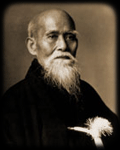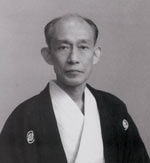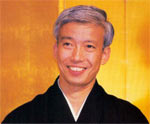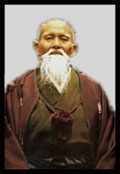Brief History of Aikido
 The history of Aikido is connected with the history of its founder, Morihei Ueshiba, and with his descendants and students.
It is a personal journey of insight which began in 1900 and is continued to the present day by millions of people worldwide.
Morihei Ueshiba was born in 1883 in the city of Tanabe of Wakayama prefecture in Southern Japan, who from a very young age showed an interest in the martial arts.
Beginning with traditional Sumo wrestling and continuing in the army (in which he fought at Manchuria) with spear and sword fighting, Morihei saught for something greater and more profound than the existing methods of fighting and wresting.
His search became more specific when, in 1915, he met Sokaku Takeda (1859 – 1943), one of the most famous teachers of the art of Jujutsu. Takeda introduced Morihei to the secrets of his art which he named Daito Ryu Aiki Jujutsu and which formed the foundation of today’s Aikido.
The history of Aikido is connected with the history of its founder, Morihei Ueshiba, and with his descendants and students.
It is a personal journey of insight which began in 1900 and is continued to the present day by millions of people worldwide.
Morihei Ueshiba was born in 1883 in the city of Tanabe of Wakayama prefecture in Southern Japan, who from a very young age showed an interest in the martial arts.
Beginning with traditional Sumo wrestling and continuing in the army (in which he fought at Manchuria) with spear and sword fighting, Morihei saught for something greater and more profound than the existing methods of fighting and wresting.
His search became more specific when, in 1915, he met Sokaku Takeda (1859 – 1943), one of the most famous teachers of the art of Jujutsu. Takeda introduced Morihei to the secrets of his art which he named Daito Ryu Aiki Jujutsu and which formed the foundation of today’s Aikido.
Another factor which contributed to the philosophy of Morihei Ueshiba (and to the art he created) was his faith in the traditional Shinto religion and in his very charismatic teacher, Onisaburo Deguchi (1871-1947). Deguchi had his own interpretation for Shinto in which he added elements from his art, from ecology and from his way of social organization. His interpretation was the result of everything he had studied and also his realization that the teachings of the elders should be modernized.It is noteworthy that shortly before WW2 the sect of Omoto Kyu, as the followers of Deguchi were called, was the most popular religion in Japan.
 Morihei Ueshiba began teaching martial arts within the Omoto Kyu structure while being both a teacher and a student of Deguchi.
Within a short period his reputation as a great teacher of the martial arts spread throughout the region, while within the sect he met many important personalities of Japanese society (high ranking army officers etc).
The decade of the 1920’s was a determining factor for him when he was exposed for a second time to war, in a mission in Mongolia.
In Mongolia, as well as at a later stage in Japan, it is said that Ueshiba was privy to metaphysical experiences which he became aware of the essence of the martial arts, and helped to establish his philosophy.
On his return he began his first dojo (martial arts school) in 1931 in Tokyo where he taught Aiki Budo, the immediate predecessor of Aikido.
Morihei Ueshiba began teaching martial arts within the Omoto Kyu structure while being both a teacher and a student of Deguchi.
Within a short period his reputation as a great teacher of the martial arts spread throughout the region, while within the sect he met many important personalities of Japanese society (high ranking army officers etc).
The decade of the 1920’s was a determining factor for him when he was exposed for a second time to war, in a mission in Mongolia.
In Mongolia, as well as at a later stage in Japan, it is said that Ueshiba was privy to metaphysical experiences which he became aware of the essence of the martial arts, and helped to establish his philosophy.
On his return he began his first dojo (martial arts school) in 1931 in Tokyo where he taught Aiki Budo, the immediate predecessor of Aikido.
The name ‘Aikido’ was given to his art in 1942 when Morihei Ueshiba, disillusioned with the war raging in Japan and throughout the world, withdrew to his farm in the region of Iwama of the prefecture of Ibaraki in Tokyo. It is there that, according to his writings, he “perfected his art” which he started to teach after the war, and even more persistently after the lifting of the allied prohibition of training in any kind of martial art. The reputation of Morihei Ueshiba before the war helped in the establishment of his school which is named Aikikai Hombu Dojo, and which today constitutes the main headquarters of Aikido throughout the world.
 An important role in the spreading of the art was played by Morihei’s son, Kisshomaru Ueshiba (1921 – 1999), who succeeded him after his death in 1969.
Following the end of the war and after, Kisshomaru Ueshiba made tremendous efforts for the correct organization and dissemination of Aikido both within
and outside Japan, since his father and founder had essentially withdrawn, and acted more as a spiritual teacher rather than as the instructor -
especially during the period 1955 – 1969. Many of the important teachers of Aikido today studied next to him, and he was also a widely published author on Aikido.
Two of his books, “Spirit of Aikido” (1984) and “Aikido” (1974) are among the most widely read books on the art.
An important role in the spreading of the art was played by Morihei’s son, Kisshomaru Ueshiba (1921 – 1999), who succeeded him after his death in 1969.
Following the end of the war and after, Kisshomaru Ueshiba made tremendous efforts for the correct organization and dissemination of Aikido both within
and outside Japan, since his father and founder had essentially withdrawn, and acted more as a spiritual teacher rather than as the instructor -
especially during the period 1955 – 1969. Many of the important teachers of Aikido today studied next to him, and he was also a widely published author on Aikido.
Two of his books, “Spirit of Aikido” (1984) and “Aikido” (1974) are among the most widely read books on the art.
Another important dimension of the contribution of Kisshomarh Ueshiba regards the organization of the teaching syllabus of Aikido. From 1969 when he took over the position of “Doshu” (head teacher) Kisshomaru Ueshiba created a comprehensive study program which became the basis for the teaching o f Aikido throughout the world. He established the basic names for the techniques, defined a system of promotions, gradings and examinations and assigned teachers from Aikido’s headquarter to oversee specific countries to be converted into Aikido centers. At the same time he participated in many demonstrations and gave hundreds of lectures which together with his literary works (over 20 books) contributed decisively in the spreading of Aikido.
 Today the work of Kisshomaru Ueshiba is continued by his son, Moriteru Ueshiba who now holds the title of Doshu, while other important teachers who have
undertaken the supervision of entire countries include Yoshimitsu Yamada in New York, Kazuo Chiba in California and Great Britain, Hiroshi Tada in Italy,
Nuboyoshi Tamura in France etc.
Today the work of Kisshomaru Ueshiba is continued by his son, Moriteru Ueshiba who now holds the title of Doshu, while other important teachers who have
undertaken the supervision of entire countries include Yoshimitsu Yamada in New York, Kazuo Chiba in California and Great Britain, Hiroshi Tada in Italy,
Nuboyoshi Tamura in France etc.



 FukuShinKan Dojo, 12 Davaki st.and 18 Mylpotamou st., 1st floor
FukuShinKan Dojo, 12 Davaki st.and 18 Mylpotamou st., 1st floor Hellenic Aikido Association on facebook
Hellenic Aikido Association on facebook Hellenic Aikido Association's YouTube channel
Hellenic Aikido Association's YouTube channel